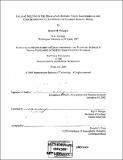| dc.contributor.advisor | Kip V. Hodges. | en_US |
| dc.contributor.author | Viskupic, Karen M. (Karen Marie), 1975- | en_US |
| dc.contributor.other | Massachusetts Institute of Technology. Dept. of Earth, Atmospheric, and Planetary Sciences. | en_US |
| dc.date.accessioned | 2010-10-12T16:08:18Z | |
| dc.date.available | 2010-10-12T16:08:18Z | |
| dc.date.copyright | 2003 | en_US |
| dc.date.issued | 2003 | en_US |
| dc.identifier.uri | http://hdl.handle.net/1721.1/59101 | |
| dc.description | Thesis (Ph. D.)--Massachusetts Institute of Technology, Dept. of Earth, Atmospheric, and Planetary Sciences, 2003. | en_US |
| dc.description | Includes bibliographical references. | en_US |
| dc.description.abstract | A combination of field studies and geochemical techniques were used to investigate the timing and processes involved in leucogranite generation in the Everest region of the Himalayan orogen. Geochemical investigations focused on samples from three outcrops at different structural levels in the Himalayan metamorphic core where in situ crustal melting and multiple generations of leucogranite intrusions were observed. Accessory phase thermochronological and U-Pb geochronological studies were combined to determine the timing of anatexis in a migmatite at the structurally lowest outcrop. Quantitative measurement of REE and Y in monazites and xenotimes, that were later dissolved and dated by U-Pb IDTIMS, revealed monazite growth at temperatures appropriate for crustal melting (>650⁰C) between 25.4 and 24.8 Ma, suggesting that anatexis was ongoing at that time. Further constraints were placed on the timing of crustal melting, granite crystallization and cooling with a detailed U-Pb IDTIMS and 40Ar/39Ar study of leucogranite dikes, sills, and the metamorphic rocks they intrude. Backscattered electron imaging of accessory minerals provided important insights into the petrogenesis of monazite, xenotime and zircon, and guided efforts to isolate accessory phase growth domains. In two granitic sills, extensive accessory phase crystallization between ca. 26 and ca. 23 Ma was interpreted to be the result of episodic to semi-continuous melt generation and crystallization at least between those times. These melt products were later entrained in melts that crystallized as syntectonic sills at 21-22 Ma. Younger crosscutting dikes crystallized between 17.5 and 18.3 Ma. | en_US |
| dc.description.abstract | (cont.) The range in accessory phase dates from these dikes and sills that represent magmatic crystallization ages spans from 26.2 to 17.5 Ma, providing evidence for melt generation in one region over roughly 9 million years. Neodymium isotopic signatures of the same monazite and xenotime grains dated by U-Pb IDTIMS were used to investigate melting processes and granite source-rock characteristics. The dominant control of monazite on the Nd isotopic composition of its host rock was clearly demonstrated. Some Nd isotopic heterogeneities recorded in monazite and in xenotime support a model for melt generation where accessory phases grow from locally derived sources in an isotopically heterogeneous melt. | en_US |
| dc.description.statementofresponsibility | by Karen M. Viskupic. | en_US |
| dc.format.extent | 186 p. | en_US |
| dc.language.iso | eng | en_US |
| dc.publisher | Massachusetts Institute of Technology | en_US |
| dc.rights | M.I.T. theses are protected by
copyright. They may be viewed from this source for any purpose, but
reproduction or distribution in any format is prohibited without written
permission. See provided URL for inquiries about permission. | en_US |
| dc.rights.uri | http://dspace.mit.edu/handle/1721.1/7582 | en_US |
| dc.subject | Earth, Atmospheric, and Planetary Sciences. | en_US |
| dc.title | Crustal melting in the Himalayan orogen : field, geochemical and geochronological studies in the Everest region, Nepal | en_US |
| dc.type | Thesis | en_US |
| dc.description.degree | Ph.D. | en_US |
| dc.contributor.department | Massachusetts Institute of Technology. Department of Earth, Atmospheric, and Planetary Sciences | |
| dc.identifier.oclc | 52710552 | en_US |
